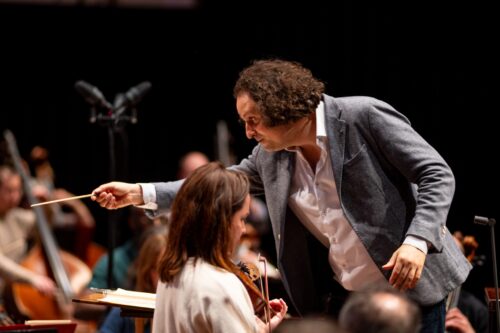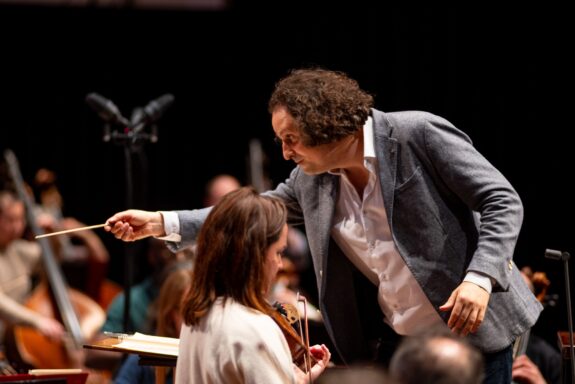 United Kingdom Debussy, Berlioz, Mussorgsky (orch. Ravel): Lise Berthaud (viola), Bournemouth Symphony Orchestra / Alexandre Bloch (conductor). Lighthouse, Poole, 9.4.2025. (CK)
United Kingdom Debussy, Berlioz, Mussorgsky (orch. Ravel): Lise Berthaud (viola), Bournemouth Symphony Orchestra / Alexandre Bloch (conductor). Lighthouse, Poole, 9.4.2025. (CK)

Debussy – Prélude à l’après-midi d’un faune
Berlioz – Harold in Italy
Mussorgsky (orch. Ravel) – Pictures at an Exhibition
I have often noticed that French and Russian composers make good bedfellows in a concert programme. It was true again here, as the Bournemouth Symphony Orchestra and French conductor Alexandre Bloch entertained us with music by Debussy, Berlioz and Mussorgsky/Ravel.
The pieces are also linked in that each of them is a response to an artwork from a different genre: Debussy to Mallarmé’s Symbolist poem, Berlioz to Byron’s then-popular Childe Harold’s Pilgrimage, and Mussorgsky to the exhibition of Victor Hartmann’s paintings mounted after the artist’s death. The musical alchemy that arises from each composer’s response to the work that inspires him is, of course, unique.
The flute in Debussy’s Prelude, sliding languidly and chromatically, dissolving the bar lines as it goes, is in its way as revolutionary as Wagner’s Tristan und Isolde. Anna Pyne wove a fragile and dreamlike spell over murmuring horns and a soft plash of harps: midday heat, dappled sunlight. Bloch’s fluid and expressive conducting released the finely wrought passion at the piece’s centre before the music subsided to its magical close, leaving us wondering, like Keats listening to his nightingale, Was it a vision, or a waking dream? Fled is that music: – do I wake or sleep?
Berlioz’s Harold in Italy is nowhere near as regularly performed as the Symphonie fantastique: it lacks the lurid drama of the earlier work (no ophicleides, no offstage instruments, no distant thunder from a quartet of timpanists – a quartet of bassoons, though). It seems uncertain about its identity – a symphony, a viola concerto, a set of tone poems? The catalyst for its composition seems to have been a request from Paganini for a viola concerto: but Berlioz, ever restless and innovative (his next ‘symphony’, Romeo and Juliet, seems more like an opera or oratorio), gives us something rather different.
Mendelssohn, writing his Italian Symphony a year earlier after an extended visit to the country, produced a vivid and formally impeccable symphony (apart from the minor-key finale) soaked in sunshine: Berlioz follows him (coincidentally?) in making his second movement a procession of pilgrims, but his ‘symphony’ is Romantic in a literary way, taking its inspiration from Byron (who was himself influenced by the ‘picturesque’ novels of Anne Radcliffe, distilled from the tales of Grand Tourists and the ‘sublime’ paintings of Salvator Rosa).
The solo viola (beautifully played by Lise Berthaud) is a thoughtful observer rather than participant: its theme – and thus its character – is lovely, reflective, instantly winning. As with the Symphonie fantastique, the opening movement is expansive and varied in mood. Bloch had the measure of it, and Berthaud maintained a beautiful line. There was a wonderful glow on the sound as the orchestra took up the tune, snapping brass and a strong, tensile string sound as the Allegro intensified.
The Pilgrims’ March was easy-paced, with its tolling horns and harp; the brief and attractive scherzo, Serenade of an Abruzzian Mountain-dweller, had a wonderful freshness – the orchestral violas and woodwind starting up a jolly country dance, the cor anglais (Holly Randall) contributing a graceful, folk-like waltz tune, taken up by clarinets and bassoons. The solo viola joined the dance shyly at first; oboe (Rebecca Kozam) and piccolo (Owain Bailey) sparkled as the pace quickened.
The concluding Brigands’ Orgy is as dramatic as we might expect, without hanging together as grippingly as the finale of the Fantastique. It is no surprise that Paganini never played the viola part, as it fades from our hearing and the soloist is stuck on the stage, tacet, for most of the finale, right to the end (a feat which Lise Berthaud achieved with stoicism and grace).
It would be churlish of me to complain about the ubiquity of Ravel’s version of Pictures at an Exhibition, when such a brilliantly effective orchestral realisation of Mussorgsky’s piano pieces is so universally and deservedly popular; but performances never quite dislodge the memory of the BSO playing (and recording) Stokowski’s version with José Serebrier around 20 years ago. Nevertheless, Bloch paced it to perfection, from a bright, confident Promenade (Paul Bosworth’s trumpet) to a thrillingly expansive Great Gate of Kiev. There was much to enjoy along the way: a malevolent Gnomus, a ripe horn (Dan Curzon) in the second Promenade, atmospheric bassoon (Tammy Thorn) and saxophone (Kyle Horch) in The Old Castle, deft and athletic flutes and woodwind in Tuileries and Ballet of the Unhatched Chicks and, between them, a booming and heavy-footed tuba (Stuart Beard) in Bydlo.
Paul Bosworth’s (muted) trumpet was back in action for a vivid depiction of whining Schmuÿle, and the market women of Limoges were dispatched with airy brilliance. From Catacombs, with wonderfully blended brass, Bloch and his players built tension and atmosphere through the terrifying entrance and relentless pounding of Baba-Yaga – horns in full cry – to the music’s stirring emergence into light and space for Mussorgsky’s thrillingly theatrical endgame.
A final word for the great work of the cymbals player – as his arms flailed and clash followed clash, I half expected him to rise from the floor and end the piece a few feet above the ground. This concert was not short of colour and excitement!
Chris Kettle
